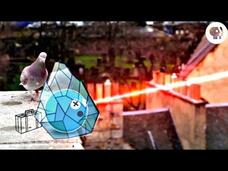Subatomic Particles Teacher Resources
Find Subatomic Particles lesson plans and worksheets
Showing 235 resources
Curated OER
Ions and Subatomic Particles
In this ions worksheet, students complete a graphic organizer by filling in the number of protons and electrons plus the charge of the given ion.
Curated OER
Defining the Atom
Words, words, words! This presentation uses plenty of them to define the atom, outline the history of what we know about atoms, and explain atomic and mass numbers. That's all! Informative, but not interesting, this slide show would be...
Curated OER
Atoms, Elements, Molecules, and Compounds
In this elements worksheet, students review the Bohr model and define negative and positive subatomic particles. Students compare molecules and compounds. This worksheet has 11 short answer questions and 4 problems to solve.
PhET
Molecule Shapes: Basics
In molecules, bonds rotate about the nucleus due to the repulsion of subatomic particles. In a simulation, learners manipulate the bonds of a molecule to meet the atoms' needs. They can then see the specific molecular shapes of five...
Curated OER
Atoms, Ions and Formula Basics Make-up Test
Using a copy of the periodic table, chemistry test takers fill in a chart with element name, chemical symbol, atomic number, atomic mass, and numbers of subatomic particles. They define subatomic particles, draw atom models, explain...
Crash Course
A Brief History of the Universe
No one was actually there to see the birth of the universe, but years of collaboration between physicists and mathematicians allow us to glimpse all but a fraction of a second of it. A narrated journey shows the phase changes...
Curated OER
What do Atoms Look Like?
In this atom worksheet, learners answer 31 multiple choice questions about the structure of atoms, the periodic table, the reactivity of elements, orbital diagrams and the families of elements.
Curated OER
Atoms and the Periodic Table
Familiarize your new chemists with the periodic table of elements by contemplating this collection of slides. Element groups are identified, atoms are defined, and nuclide notation is explained. Isotopes are also mentioned. The topics...
Curated OER
Teaching Atomic Structure Using Cooperative Learning
Individuals in a group of four each take on a different role: atomic number expert, mass number expert, isotope expert, and nuclear atom expert. They teach each other about their area of expertise. As an assessment, a short quiz is...
Curated OER
Atomic Structure
The first nine slides visit the history of our understanding of atoms. The next several outline the structure of atoms. Subatomic particles, electron configuration, and diagramming methods are introduced. This is a neatly organized...
Educreations
Electron Configuration Example
What does an atom look like? The instructor in a tutorial video models how to use the periodic table to determine the number of subatomic particles. He then uses the number of electrons to create an orbital diagram. Finally, Groves...
Bowels Physics
Electrostatics
Explore behavior of particles that cannot be seen with a detailed PowerPoint presentation that outlines the basics of electrostatics. The presentation addresses the charge of subatomic particles, conductors and insulators,...
Ricochet Science
Understanding Atomic Number and Atomic Mass
The amount of information you can learn about an element from the periodic table is amazing! Young scientists learn how to interpret the atomic number and atomic mass. Using a carbon atom as an example, the instructor describes the...
Fuse School
The Atom: Part 2 - Isotopes
How can atoms with different masses be the same element? An interactive video lesson describes the meaning of an isotope. The instructor emphasizes the relationship among the subatomic particles. The lesson continues by discussing...
Fuse School
Atomic Number and Mass Number
Discover the significance of the atomic number and mass number. A video lesson describes the relationship between the two numbers and the subatomic particles. The instructor leads several examples that use the two numbers to determine...
MinutePhysics
A Brief History of Everything feat. Neil deGrasse Tyson
Explore the creation of the world as we know it today! An engaging narrator uses a storytelling approach to describe the creation of the universe through black holes. He continues to explain the behavior of subatomic particles as they...
Fuse School
How Atoms Bond - Elements and Compounds Part 1
Ionic, covalent, metallic, oh my! Atoms use various methods of bonding to form molecules. The video lesson provides an overview of the different types and the role of the subatomic particles in bonding.
Teacher's Pet
Atoms
Discover the relationship between mass number, atomic number, and the makeup of the atom. The video instructor explains how to determine the number of each subatomic particle from the atomic and mass number. She demonstrates multiple...
Teacher's Pet
The Nucleus
Explore the makeup of the atomic nucleus. A video lesson describes the subatomic particles of the nucleus. The instructor explains the connection between the mass and atomic numbers and the isotopes of an atom.
Physics Girl
How Does Laser Cooling Work?
We typically think of lasers adding heat energy, but lasers can be used for cooling, too! An episode of a physics playlist discusses the science of lasers. Learners watch how to place lasers to effectively slow subatomic particles.
Mystery of Matter
Mysteries of the Periodic Table, Part 1: A Reflection of the Atom
Properties of atoms are no small thing. A thorough video lesson describes properties of atoms and how they relate to the makeup of the periodic table. Learners review the relationship between subatomic particles and discover the...
Mystery of Matter
Mysteries of the Periodic Table, Part 2: The Rare Earths
Seeing is believing, but seeing is difficult when identifying elements by their subatomic particles. Learners take a trip through history to identify the rare earth elements to learn the struggle of separating the very similar elements....
LABScI
Atomic Structure and the Periodic Table of Elements: The Secret Agent Lab
Food always gets attention! Model atomic structure using fruit loops to represent the subatomic particles. After building models, scholars create ionic bonds using their models. Finally, they use these concepts to create a periodic...
Cornell University
Isotopes
What better way is there to learn about isotopes than to play with them? Chemistry young scholars manipulate the number of protons and neutrons in a hands-on activity. Individuals try to score the largest number of...

























